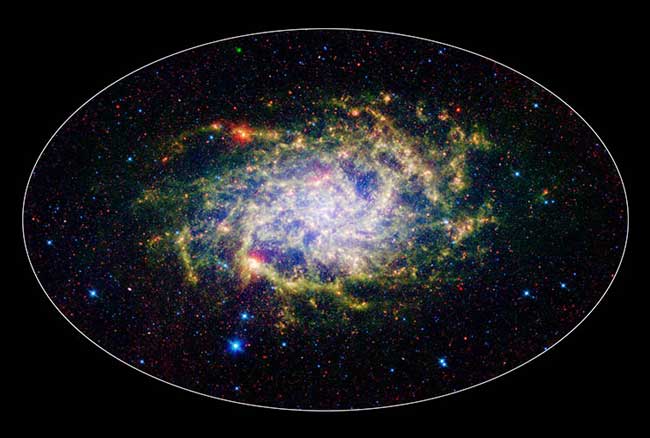Nearby Galaxy Looks Bigger in Infrared

One of our closest galactic neighbors is M33, also known as the Triangulum Galaxy. It is a member of what's known as the Local Group of galaxies.
A new infrared image from NASA's Spitzer Space Telescope reveals the colorful M33 to be surprising large -- bigger than its visible-light appearance would suggest, astronomers said in a recent statement.
With its ability to detect cold, dark dust, Spitzer sees emission from cooler material well beyond the visible range of M33's disk. Exactly how this cold material moved outward from the galaxy is still a mystery, but winds from giant stars or supernovas may be responsible, Spitzer astronomers said.
Along with our own Milky Way, galaxies in the the Local Group are all bound by gravity. This binding can create collisions. The Milky Way has absorbed many smaller galaxies, and eventually we'll have a wrenching head-on with the Andromeda Galaxy, a match for us size-wise and recently found to be much larger than was known.
M33, the third largest galaxy in our group, is also moving toward the Milky Way (which is about 100,000 light-years in diameter). Nothing to worry about, however. This galactic cousin is presently some 2.9 million light-years away in the constellation Triangulum.
A light-year is the distance light travels in one year, about 6 trillion miles (10 trillion kilometers).
While M33 is a spiral galaxy like our own, it is quite different. It has little or no central bulge of stars, and astronomers figure if it has a central black hole, the mass of it is probably no more than 3,000 times that of our sun. Our Milky Way's central black hole, on the other hand, is a few million solar masses.
Get the Space.com Newsletter
Breaking space news, the latest updates on rocket launches, skywatching events and more!
- Video: When Galaxies Collide
- Gallery of Galactic Collisions
- Milky Way Image Gallery
Join our Space Forums to keep talking space on the latest missions, night sky and more! And if you have a news tip, correction or comment, let us know at: community@space.com.

Space.com is the premier source of space exploration, innovation and astronomy news, chronicling (and celebrating) humanity's ongoing expansion across the final frontier. Originally founded in 1999, Space.com is, and always has been, the passion of writers and editors who are space fans and also trained journalists. Our current news team consists of Editor-in-Chief Tariq Malik; Editor Hanneke Weitering, Senior Space Writer Mike Wall; Senior Writer Meghan Bartels; Senior Writer Chelsea Gohd, Senior Writer Tereza Pultarova and Staff Writer Alexander Cox, focusing on e-commerce. Senior Producer Steve Spaleta oversees our space videos, with Diana Whitcroft as our Social Media Editor.









